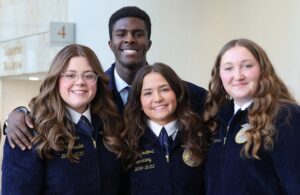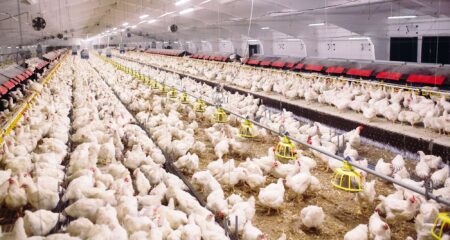Groups pushing for more help from the federal government to address the country’s shortage of rural veterinarians are cheering a USDA plan to help pay off veterinary school debt and engage the Economic Research Service to analyze where shortages are most acute.
The Rural Veterinary Action Plan will increase the amount available under the Veterinary Medicine Loan Repayment Program from $10 million to $25 million, enabling more applicants to get awards, and streamline the application process for that program and the Veterinary Services Grant Program, which had $3.8 million available in its last funding pool.
USDA also will look at ways to boost employment of federal veterinarians, who are consistently paid less than their private-sector counterparts.
“As the number of rural food animal veterinarians continues to decline, USDA is putting farmers first to ensure we build back our first line of defense in our animal food production system – the rural veterinarian,” Agriculture Secretary Brooke Rollins said in a news release announcing the plan.
“With these new investments in scholarships and pay incentives, USDA is not only strengthening our animal food production system but also listening to producers and veterinarians across the country to ensure our programs meet real-world needs.”
Numerous studies have pointed out the decline in rural vets over the past few decades. A report issued in late 2022 by the Farm Journal Foundation found about 500 rural counties nationwide were in need of vets. In addition, the foundation found that between 3% to 4% of new vet school grads “pursue livestock or other food-animal practice areas, a stark decline from 40 years ago when about 40% of graduates specialized in this area.”
“You don’t see as many people that are interested in doing that type of work applying to vet school,” said Andy Berry, a cow-calf operator in Mississippi who also is executive vice president of the Mississippi Cattlemen’s Association. Berry complimented the Trump administration for the plan, noting he is “enthused to see some focus on rural issues.”
Berry is “probably 45 minutes to the closest [vet] that will do large animal veterinarian work,” he said. “For routine stuff, you got to schedule out there pretty good. And then for emergency things, it certainly can be challenging to find somebody when that pops up.”
Berry said he’s worried about the shortage not only making routine care more difficult, but exacerbating any problems that may arise if New World screwworm makes it to the U.S.
“It’s concerning with screwworm lingering out there of not enough large animal veterinarians to go around,” he said.
Joe Annelli, executive vice president of the National Association of Federal Veterinarians, told Agri-Pulse the USDA plan is definitely helpful. “In general, I think it’s really good,” he said.
But his group also would like to see the federal government look more closely at the situation of veterinarians in the public sector. Instead of an ERS report, the group would like the Government Accountability Office to examine the issue, which it hasn’t done in 10 years.
In a letter to Rollins after the plan came out, Annelli said, “A GAO report would provide critical insight into workforce trends, retirement risks, geographic distribution, recruitment challenges, and future service demands. Such comprehensive data will empower policymakers to fine‑tune programs like the action plan and more effectively allocate resources.”
Most vet-school grads end up treating companion animals — cats and dogs, primarily. They do that because the pay is better and they have debt to pay; the action plan said the average debt is $202,647. The jobs are also generally less stressful.
NAFV also is drawing attention to a pay gap between private-sector and public-sector vets.
“We believe that exploring special pay rates, streamlined recruitment and retention bonuses, and improved career advancement opportunities are key to closing this gap,” Annelli said in his letter to Rollins.
The action plan says USDA “will explore opportunities to increase pay and career advancement opportunities for federal veterinarians, including exploring the establishment of special rates of pay for veterinarians.”
FJF has highlighted the rural vet shortage since 2022. Katie Lee, the foundation’s vice president of government affairs, said “a lot of the recommendations are very consistent with things that we’ve been advocating for some time.”
That stands to reason, as “some of the key folks at USDA are quite knowledgeable on this issue and either worked for us previously or worked closely with us previously,” she said. One is Kelsey Barnes, former FJF director of government affairs who this year became senior adviser to Rollins for rural development, biofuels, and research, education and economics.
Lee said the plan is a solid first step but added that the way shortage areas are identified needs to be improved. Currently, the National Institute of Food and Agriculture reviews nominations for shortage areas from state health officials.
“I believe the secretary [of agriculture] has quite a bit of authority in how they instruct the states to select shortage areas, and the shortage areas rotate year on year,” she said. However, she said, “In reality, a shortage area last year is probably still a shortage area. But then if somebody is applying for one of these federal programs, they’re ineligible if it’s not a shortage area in that year. So, there’s some ways that I think we can support the issue in the details of this plan.”
“We don’t know what the actual gap is” between the number of rural vets working now and the number that are needed, Annelli said.
Lee said that NIFA’s loan repayment program could reach more people if taxes weren’t lopped off the awards before they’re given to recipients.
“So, essentially every award that’s given out through the VMLRP is taxed ahead of the award being disseminated to the recipient,” Lee said. “And so you’re losing a third of the appropriated dollars [to] the Treasury, and you could reach up to a third additional applicants just by fixing that element.”
Bills introduced in the House and the Senate would address the tax issue.
This article was originally published by Agri-Pulse. Agri-Pulse is a trusted source in Washington, D.C., with the largest editorial team focused on food and farm policy coverage.


:max_bytes(150000):strip_icc()/IMG_1591-2048x1365-362687ca596f4814967abffff2b4be2c.jpg)
:max_bytes(150000):strip_icc()/SuccessfulFarmingShareImage-8fed6410b43147a19ed5ea1e3243227f.png)



:max_bytes(150000):strip_icc()/52036081883_b07263d4e0_o-c0cfd21a759a4524baab99983ccde043.jpg)

:max_bytes(150000):strip_icc()/IMG_7575-ac6db3006a2145109bcc2df421c7a962.jpeg)

:max_bytes(150000):strip_icc()/Markets-3-Corn-up-3-19bdbeee0041452db8bce0a0f1c8b883.jpeg)